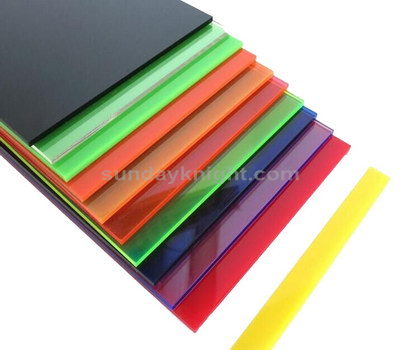Acrylic sheets, also known as plexiglass or acrylic glass, have become increasingly popular in various industries due to their unique characteristics and the continuous technological innovations that have improved their versatility and applications. In this article, we will explore the key characteristics of acrylic sheets and discuss the recent technological advancements that have expanded their utility in diverse fields.

Characteristics of Acrylic Sheets
- Transparency and Clarity:
One of the most notable features of acrylic sheets is their exceptional transparency and optical clarity. They offer a level of transparency that is often superior to glass, making them a preferred choice in applications where visual aesthetics and transparency are crucial, such as museum displays, architectural glazing, and aquariums. - Impact Resistance:
Acrylic sheets are remarkably resilient and offer high impact resistance. They are about ten times more impact-resistant than glass of the same thickness, making them an excellent choice for safety barriers, protective shields, and products that need to withstand physical impacts. - Lightweight:
Compared to glass, acrylic sheets are significantly lighter, which makes them easier to handle and install. This characteristic is particularly advantageous in industries like aviation, where reducing weight can lead to fuel savings and increased efficiency. - UV Resistance:
Acrylic sheets are naturally resistant to the harmful effects of ultraviolet (UV) radiation. This UV resistance makes them ideal for outdoor applications, such as signage, skylights, and greenhouse construction, as they do not yellow or degrade when exposed to sunlight. - Versatility:
Acrylic sheets can be easily cut, shaped, and fabricated, making them highly versatile. This ease of manipulation allows for a wide range of creative applications, including custom-made displays, artistic installations, and architectural elements.
Technological Innovations
- Anti-Scratch Coatings:
In recent years, technological advancements have led to the development of anti-scratch coatings for acrylic sheets. These coatings provide a protective layer that minimizes surface damage from everyday wear and tear, improving the longevity and visual appeal of acrylic products. - UV Filtering:
For applications where UV protection is essential, advancements in UV-filtering coatings have made acrylic sheets even more attractive. These coatings can block a high percentage of harmful UV rays, ensuring that sensitive materials or artworks are preserved over time. - Thermal Insulation:
Acrylic sheets are naturally better insulators than glass. However, technological innovations have led to the creation of multi-layered acrylic sheets with enhanced thermal insulation properties. These sheets help regulate temperature, reducing energy consumption in applications like greenhouses and climate-controlled enclosures. - UV Printing:
The introduction of UV printing technology has expanded the potential uses of acrylic sheets. This printing method allows for high-resolution images, designs, and patterns to be directly printed onto acrylic surfaces, opening up new possibilities in the signage, advertising, and interior design industries. - Acoustic Properties:
In architectural and interior design, acrylic sheets have benefited from innovations in acoustic properties. These sheets can be designed with sound-dampening features, providing a practical solution for noise reduction in commercial spaces, offices, and public venues. - Self-Healing Surfaces:
Technological advancements have led to the development of self-healing acrylic surfaces. These materials have the ability to repair minor scratches and blemishes when exposed to heat or certain chemicals, reducing maintenance requirements and extending the lifespan of acrylic products.
Conclusion
Acrylic sheets possess a remarkable set of characteristics, including transparency, impact resistance, and versatility, making them highly sought after in various industries. Recent technological innovations have further expanded the utility of acrylic sheets by enhancing their durability, UV protection, thermal insulation, and acoustic properties. As these advancements continue, the future of acrylic sheets holds promise in creating even more applications across a wide spectrum of industries, from art and design to construction and technology.
